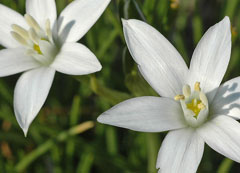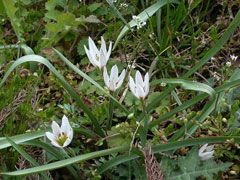 |
|
http://www.flickr.com/photos/56119072@N00/401814220 |
 |
| http://commons.wikimedia.org/wiki/User:Keisotyo |
Translate this page:
Summary
Physical Characteristics

 Tulipa edulis is a BULB growing to 0.2 m (0ft 8in) at a slow rate.
Tulipa edulis is a BULB growing to 0.2 m (0ft 8in) at a slow rate.
See above for USDA hardiness. It is hardy to UK zone 7 and is not frost tender. It is in flower from March to April, and the seeds ripen from May to June. The species is hermaphrodite (has both male and female organs).
Suitable for: light (sandy) and medium (loamy) soils and prefers well-drained soil. Suitable pH: mildly acid, neutral and basic (mildly alkaline) soils. It cannot grow in the shade. It prefers moist soil.
UK Hardiness Map
US Hardiness Map
Synonyms
T. graminifolia. Amana edulis. A. graminifolia. Orithyia edulis.
Plant Habitats
Cultivated Beds; East Wall. By. South Wall. By.
Edible Uses
Edible Parts: Leaves Root
Edible Uses:
Bulb - cooked[22, 105]. A source of starch[46, 61]. The bulb can be up to 4cm in diameter[266]. Leaves - cooked[46, 61, 105]. Unless you have more plants than you need this practise is not recommended since it will greatly weaken the plant[K].
References More on Edible Uses
Medicinal Uses
Plants For A Future can not take any responsibility for any adverse effects from the use of plants. Always seek advice from a professional before using a plant medicinally.
Antidote Antipyretic Cancer Depurative Expectorant Febrifuge Laxative
The inner portion of the bulb is antidote, antipyretic, depurative, expectorant, febrifuge and laxative[147, 218]. It is used, mainly as a poultice, in the treatment of ulcers and abscesses[147]. The plant has been used in the treatment of cancer[218]. The leaves are applied externally to abscesses, buboes and breast diseases[218]. The flowers are used in the treatment of dysuria[218].
References More on Medicinal Uses
The Bookshop: Edible Plant Books
Our Latest books on Perennial Plants For Food Forests and Permaculture Gardens in paperback or digital formats.

Edible Tropical Plants
Food Forest Plants for Hotter Conditions: 250+ Plants For Tropical Food Forests & Permaculture Gardens.
More

Edible Temperate Plants
Plants for Your Food Forest: 500 Plants for Temperate Food Forests & Permaculture Gardens.
More

More Books
PFAF have eight books available in paperback and digital formats. Browse the shop for more information.
Shop Now
Other Uses
References More on Other Uses
Cultivation details
Easily grown in a well-drained soil in a sunny position[1, 90]. This species is not fully hardy in Britain, the plants come into growth in the winter and need protection from severe weather and so are best grown in a bulb frame[1]. Plants are dormant in summer but do not require protection from rain[90]. Bulbs can be harvested in June after they have died down and then stored in a cool dry place, being planted out again in October.
References Carbon Farming Information and Carbon Sequestration Information
Temperature Converter
Type a value in the Celsius field to convert the value to Fahrenheit:
Fahrenheit:
The PFAF Bookshop
Plants For A Future have a number of books available in paperback and digital form. Book titles include Edible Plants, Edible Perennials, Edible Trees,Edible Shrubs, Woodland Gardening, and Temperate Food Forest Plants. Our new book is Food Forest Plants For Hotter Conditions (Tropical and Sub-Tropical).
Shop Now
Plant Propagation
Seed - best sown in a shady part of the cold frame as soon as it is ripe in early summer[1], or in the early autumn[200]. A spring sowing of stored seed in the greenhouse also succeeds[K]. Sow the seed thinly so that the seedlings can be grown on without disturbance for their first growing season - apply liquid feeds to the pot if necessary. Divide the bulbs once the plants have become dormant, putting 3 - 4 bulbs in each pot. Grow the on in the greenhouse for at least the next year, planting them out when dormant. Division of offsets in July. Larger bulbs can be planted out straight into their permanent positions, or can be stored in a cool place and then be planted out in late autumn. It is best to pot up smaller bulbs and grow them on in a cold frame for a year before planting them out when they are dormant in late summer to the middle of autumn.
Other Names
If available other names are mentioned here
Native Range
TEMPERATE ASIA: China (Anhui Sheng, Zhejiang Sheng, Hunan Sheng, Hubei Sheng, Jiangxi Sheng, Jiangsu Sheng, Liaoning Sheng, Shandong Sheng, Shaanxi Sheng), Japan (Honshu, Kyushu, Shikoku), Korea, South
Weed Potential
Right plant wrong place. We are currently updating this section.
Please note that a plant may be invasive in one area but may not in your area so it's worth checking.
Conservation Status
IUCN Red List of Threatened Plants Status :

Growth: S = slow M = medium F = fast. Soil: L = light (sandy) M = medium H = heavy (clay). pH: A = acid N = neutral B = basic (alkaline). Shade: F = full shade S = semi-shade N = no shade. Moisture: D = dry M = Moist We = wet Wa = water.
Now available:
Food Forest Plants for Mediterranean Conditions
350+ Perennial Plants For Mediterranean and Drier Food Forests and Permaculture Gardens.
[Paperback and eBook]
This is the third in Plants For A Future's series of plant guides for food forests tailored to
specific climate zones. Following volumes on temperate and tropical ecosystems, this book focuses
on species suited to Mediterranean conditions—regions with hot, dry summers and cool, wet winters,
often facing the added challenge of climate change.
Read More
Expert comment
Author
(Miq.)Baker.
Botanical References
58200266
Links / References
For a list of references used on this page please go here
Readers comment
| Add a comment |
|
If you have important information about this plant that may help other users please add a comment or link below. Only comments or links that are felt to be directly relevant to a plant will be included. If you think a comment/link or information contained on this page is inaccurate or misleading we would welcome your feedback at [email protected]. If you have questions about a plant please use the Forum on this website as we do not have the resources to answer questions ourselves.
* Please note: the comments by website users are not necessarily those held by PFAF and may give misleading or inaccurate information.
To leave a comment please Register or login here All comments need to be approved so will not appear immediately.
|
|